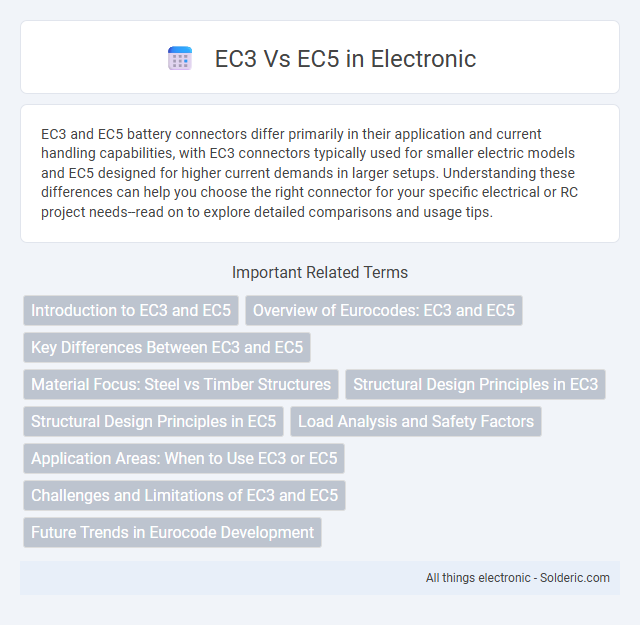EC3 and EC5 battery connectors differ primarily in their application and current handling capabilities, with EC3 connectors typically used for smaller electric models and EC5 designed for higher current demands in larger setups. Understanding these differences can help you choose the right connector for your specific electrical or RC project needs--read on to explore detailed comparisons and usage tips.
Comparison Table
| Feature | EC3 | EC5 |
|---|---|---|
| Type | European Design Standard for Composite Beams | European Design Standard for Timber Connections |
| Application | Steel-concrete composite beams and slabs | Timber joints and fasteners |
| Focus | Structural design, fire resistance, durability of composite beams | Design of nailed, bolted, and screwed timber connections |
| Scope | Steel and concrete interaction in composite structures | Load bearing capacity and deformation of timber connections |
| Material | Steel and concrete | Timber and fasteners (metal connectors) |
| Relevant Standard Number | EN 1994 (Eurocode 4) | EN 1995 (Eurocode 5) |
Introduction to EC3 and EC5
EC3 and EC5 are structural design codes commonly used in engineering to ensure the safety and reliability of building components under various loads. EC3, or Eurocode 3, focuses on the design of steel structures, providing detailed guidelines for material properties, structural analysis, and stability requirements. EC5, or Eurocode 5, covers the design of timber structures, including wood properties, connection details, and durability considerations essential for sustainable construction.
Overview of Eurocodes: EC3 and EC5
Eurocode 3 (EC3) governs the design of steel structures, providing comprehensive guidelines for strength, stability, and durability under various loads. Eurocode 5 (EC5) focuses on timber structures, addressing the unique properties and behavior of wood, including load-bearing capacity and connection methods. Your choice between EC3 and EC5 depends on whether your project requires steel or timber design standards, ensuring structural safety and compliance with European regulations.
Key Differences Between EC3 and EC5
EC3 and EC5 software differ mainly in their target applications and feature sets, with EC3 focusing on cloud cost management and optimization, while EC5 emphasizes advanced cloud governance and security compliance. EC3 provides streamlined tools for continuous cost monitoring and resource utilization, enhancing your cloud expenditure efficiency. EC5 offers comprehensive policy enforcement and risk management features, making it ideal for organizations seeking robust security controls alongside cost oversight.
Material Focus: Steel vs Timber Structures
EC3 provides comprehensive design rules specifically tailored for steel structures, addressing material properties such as yield strength, ductility, and thermal expansion to ensure optimal structural performance and safety. EC5, on the other hand, focuses on timber structures, encompassing guidelines for assessing wood characteristics like moisture content, strength classes, and long-term behavior under loading. The distinct approaches in EC3 and EC5 reflect the fundamental differences in mechanical behavior and environmental sensitivity between steel and timber materials.
Structural Design Principles in EC3
EC3 (Eurocode 3) establishes comprehensive structural design principles specifically for steel structures, emphasizing safety, serviceability, and durability through limit state design methods. It incorporates detailed guidelines on material properties, cross-section classification, and stability analysis to ensure robust and reliable steel framework performance under various loading conditions. These principles support optimized structural efficiency, addressing aspects like buckling resistance, fatigue, and connection design critical in modern steel construction.
Structural Design Principles in EC5
EC5, the European standard for timber design, emphasizes structural design principles such as durability, fire resistance, and serviceability, ensuring timber structures meet safety and performance requirements. It specifies methods for calculating bending, shear, and axial forces, incorporating factors for load duration, moisture content, and partial safety factors tailored for wood. Compared to EC3, which focuses on steel structures, EC5 addresses timber-specific behaviors like anisotropy and creep, promoting optimized, sustainable construction.
Load Analysis and Safety Factors
EC3 (Eurocode 3) and EC5 (Eurocode 5) differ significantly in load analysis and safety factors, reflecting the distinct characteristics of steel and timber structures. EC3 employs precise load combinations and partial safety factors tailored for steel's high strength and ductility, ensuring structural reliability under variable loads. Your design's safety is optimized in EC5 by incorporating timber-specific factors like moisture effects, load duration, and material variability, addressing timber's unique behavior under stress.
Application Areas: When to Use EC3 or EC5
EC3 is primarily applied in Europe for designing steel structures under the Eurocode framework, suitable for buildings and civil engineering constructions requiring harmonized standards across member states. EC5 specifically addresses timber structures, providing detailed guidance for wood-based construction projects such as residential homes, bridges, and public buildings where timber is the main material. Use EC3 for steel design compliance and EC5 for structural timber design to ensure adherence to region-specific material properties and loading conditions.
Challenges and Limitations of EC3 and EC5
EC3 faces challenges in scalability and interoperability due to limited support for diverse blockchain protocols, which restricts its application across various industries. EC5 encounters limitations with higher computational requirements and increased energy consumption, impacting its efficiency in resource-constrained environments. Both EC3 and EC5 struggle with regulatory compliance issues and lack standardized frameworks, hindering widespread adoption and integration.
Future Trends in Eurocode Development
Eurocode 3 (EC3) focuses on the design of steel structures, while Eurocode 5 (EC5) covers timber design, both evolving to incorporate enhanced sustainability and resilience standards. Future trends in Eurocode development emphasize integrating advanced computational methods and addressing climate change impacts to improve structural safety and efficiency. Your engineering projects will benefit from these updates through more robust, environment-conscious design frameworks.
EC3 vs EC5 Infographic

 solderic.com
solderic.com